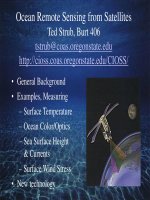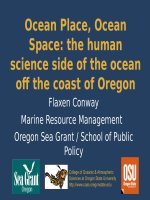Geography and Oceanography - Chapter 10 ppsx
Bạn đang xem bản rút gọn của tài liệu. Xem và tải ngay bản đầy đủ của tài liệu tại đây (1.73 MB, 39 trang )
The Properties of Sea Water
What makes water so special?
Why is the ocean salty?
Where’s the Water?
Reservoir Volume (10
6
km
3
) Percent
Ocean 1370 97.3
Ice (polar) 29 2.1
Groundwater 5 0.4
Lakes 0.1 0.01
Atmosphere 0.01 0.001
Rivers 0.001 0.0001
Where did the water in the
Oceans come from?
Outgassing (H
2
O, CO
2
) of the Earth
from volcanoes, early in its history,
but continuing today
Sedimentary rocks as old as 3.8
billion years!
A much smaller amount from comets
that pass by
The Water Molecule
Water is a “Polar” Molecule
Weak electrical attraction makes for
“sticky” molecules
This explains its unique properties:
heat capacity
surface tension
dissolving power
Temperature vs Heat
Temperature is a measure of how
fast the molecules in a substance are
moving
Heat is a measure of how much
energy has to be put into (or gotten
out of) a substance to change its
temperature, or “state” (solid, liquid,
gas)
Sensible Heat vs Latent Heat
Sensible heat is what we sense from
different temperatures; energy needed to
raise T (or released to decrease T)
Latent heat is the energy needed to
change state (ice to water, water to
vapor)
ice
water vapor
water vapor
liquid water
liquid water
Exists in three states on the planet surface
Exists in three states on the planet surface
Changes of state
Water co-exists on the Earth in 3 physical states: Habitable Planet
solid
solid
liquid
liquid
gas
gas
Changes of state always occur
Changes of state always occur
at
at
constant temperature
constant temperature
The heat needed for a change of state
The heat needed for a change of state
is called
is called
latent heat
latent heat
Heat and the three Physical
States of Water:
Evaporation
Evaporation
from lakes, oceans,
from lakes, oceans,
rivers, etc. occurs for
rivers, etc. occurs for
temperatures lower than 100
temperatures lower than 100
o
o
C
C
But it
But it
requires
requires
more energy
more energy
to do so
to do so
Energy removed from surface (evaporation)
Energy removed from surface (evaporation)
Energy liberated into the
Energy liberated into the
atmosphere (condensation)
atmosphere (condensation)
Major source of energy to power
Major source of energy to power
the Earth’s weather systems
the Earth’s weather systems
Density of Pure Water
Consequences…
Consequences
Bottom temperature of deep, cold lakes is always
4
o
C.
Ice floats on the water surface, so fish survive.
Pipes (or beer bottles) can freeze and burst.
Surface tension
Surface tension
-
-
measure of how
measure of how
difficult it is to stretch or break the
difficult it is to stretch or break the
surface of a liquid
surface of a liquid
Water has the highest surface tension of all common liquids
Water has the highest surface tension of all common liquids
Special Properties of Water
Density of solid is less than liquid
Melting and boiling points are very
high
Highest heat capacity
High heat of fusion and vaporization
Tremendous dissolving power
Dissolving Power of Water
Why is the Ocean Salty?
Total dissolved solids (called “salinity”)
About 3.5% by weight (average
seawater)
Usually expressed as 35
0
/
00
(parts per
thousand, ppt)
Varies geographically according to
Evaporation, Precipitation, and Rivers
The Most Abundant Ions
Chloride (Cl
-
) 19.0 g/kg
Sodium (Na
+
) 10.6 “
Sulfate (SO
4
2-
) 2.6 “
Magnesium (Mg
2+
) 1.2 “
Calcium (Ca
2+
) 0.4 “
Potassium (K
+
) 0.4 “
35.2 g/kg
Ions in Sea Water
Anions are negatively charged
examples: Cl
-
, SO
4
-
Cations are positively charged
examples: Na
+
, K
+
, Ca
++
, Mg
++
Measuring Salinity
Principle of Constant Proportions
e.g., SO
4
2-
/Cl
-
is a constant,
independent of salinity
This means we need measure only one
ion to get salinity; i.e., Cl
-
Today salinity is measured quickly by
electrical conductivity of sea water
Where does Salinity come from?
Terrigenous input (rivers, dust, ash)
Hydrothermal vents
Dissolving old sediments (evaporites)
Steady State: Inputs equal Outputs









